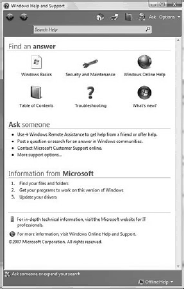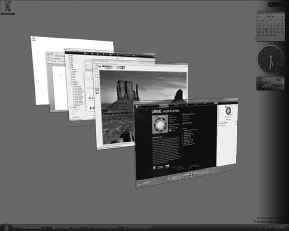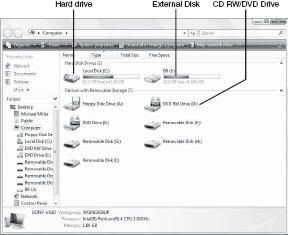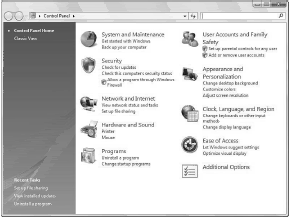Using Windows Vista Start Menu
All the software programs and utilities on your computer are accessed via Windows’ Start menu. You display the Start menu by using your mouse to click the Start button, located in the lower-left corner of your screen. As you can see in Figure 1, the Windows Vista Start menu consists of two columns of icons.
Your most frequently and recently used programs are listed in the left column; basic Windows utilities and folders are listed in the right column. To open a specific program or folder, just click the name of the item.
To view the rest of your programs, click the All Programs arrow. This displays a new submenu called the Programs menu. From here you can access various programs, sorted by type or manufacturer. (When more programs are contained within a master folder, you’ll see an arrow to the right of the title; click this arrow to expand the menu and display additional choices.)
By the way, the All Programs menu works differently in Windows Vista than in Windows XP. In Windows XP, clicking a right arrow caused the menu to cascade to the right; in Vista, clicking a right arrow simply expands the menu in-place, which takes up a lot less screen space.
Launching a Program
Now that you know how to work the Start menu, it’s easy to start any particular software program. All you have to do is follow these steps:
- Click the Start button to display the Start menu.
- If the program is displayed on the Start menu, click the program’s icon.
- If the program isn’t visible on the main Start menu, click the All Programs button, find the program’s icon, and then click it.
Another way to find a program to launch is to use the Instant Search box on the Start menu. Just start entering the program’s name into the search box, and a list of matching programs appears on the Start menu. When the program you want appears, click it to launch it.
Switching Between Programs
After you’ve launched a few programs, it’s easy to switch from one program to another. Windows Vista offers several different ways to switch between programs, including:
- Click any visible part of the application’s window, which brings that window to the front.
- Click the application’s button in the taskbar, as shown in Figure 2. (And here’s a tip; if you hover your cursor over a taskbar button, you’ll see a “live” thumbnail of the open document or application.)
- Hold down the Alt key and then press the Tab key repeatedly until the application window you want is selected. This is called Windows Flip and cycles through thumbnails of all open windows, as shown in Figure 3. When you’re at the window you want, release the Alt key.
- Hold down the Start button and then press the Tab key to activate the Flip 3D feature. This displays a three-dimensional stack of all open windows, as shown in Figure 4. Continue pressing the Tab key (or rotate the scroll button on your mouse) to cycle through the windows on the stack.
Using Windows Explorers
In Windows Vista, all the items stored on your computer—including programs, documents, and configuration settings—are accessible from special windows, called Explorers. You use Explorers to find, copy, delete, launch, and even configure programs and documents.
There are many different Explorers in Windows Vista. For example, when you click the Music icon on the Start menu, you open the Music Explorer, which then displays all the songs you have stored on your system, as shown in Figure 5.
Likewise, clicking the Photos icon opens the Photos Explorer, which displays all the digital photographs on your system. Perhaps the most-used Explorer is the Documents Explorer, which is where you’ll find practically all of the documents, photos, music, and other files stored on your computer’s hard disk.
Click the Documents icon on the Start menu, and you see a window full of folders, such as the one shown in Figure 6.
Double-click a folder icon to view the contents of that folder—which could be individual files or additional folders (sometimes called subfolders). To launch a program or open a document, double-click that item’s icon. To perform other tasks (copying, deleting, and so forth), right-click the icon and select an option from the pop-up menu.
Managing PC Resources
The Computer Explorer lets you access each major component of your system and perform basic maintenance functions. For example, you can use the Computer Explorer to “open” the contents of your hard disk and then copy, move, and delete individual files.
To open the Computer Explorer, simply click the Computer icon on the Start menu. As you can see in Figure 7, the Computer Explorer contains icons for each of the major components of your system—your hard disk drive, external drives, CD-ROM or DVD drive, and so on.
To view the contents of a specific drive, simply double-click the icon for that drive. You’ll see a list of folders and files located on that drive; to view the contents of any folder, just double-click the icon for that folder.
Windows Control Panel
There’s one more Windows Explorer, similar to the Computer Explorer, that you need to know about. This Explorer, called the Control Panel, is used to manage most of Windows’ configuration settings.
To open the Control Panel, click the Control Panel icon on the Start menu. When the Control Panel opens, as shown in Figure 8, you can select a particular category you want to configure.
Each item you select opens a window with a different set of options; just keep clicking until you find the specific item you want to configure.
Windows is more than just a pretty desktop and some configuration utilities. Windows also includes many accessory programs and system tools you can use to perform other basic system operations. Windows includes a number of single-function accessory programs, all accessible from the Start menu.
These programs include a calculator, some games, two basic word processors (Notepad and WordPad), a drawing program (Paint), a player for audio and video files (Windows Media Player), a photo management/editing program (Windows Photo Gallery), a digital video editing program (Windows Movie Maker), a DVD burning program (Windows DVD Maker), and more.
You access all of these accessories from the Start menu and by selecting All Programs. Some programs are right on the All Programs menu; others are a level down on the Accessories menu. In addition to the Windows accessories, Windows Vista also gives you three important Internet utilities.
These include a web browser (Internet Explorer 7), an email program (Windows Mail), and a web-based calendar/scheduler program (Windows Calendar). All three of these programs are on the All Programs menu.
Finally, Windows Vista includes a handful of technical tools you can use to keep your system running smoothly. You can access all these tools by clicking the Start button and selecting All Programs, Accessories, System Tools.
Getting Help in Windows
When you can’t figure out how to perform a particular task, it’s time to ask for help. In Windows Vista, this is done through the Help and Support Center. To launch the Help and Support Center, click the Start button and then select Help and Support.

The Help and Support Center, lets you search for specific answers to your problems, browse the table of contents, connect to another computer for remote assistance, go online for additional help, and troubleshoot any problems you may be having. Click the type of help you want and follow the onscreen instructions from there.
Shutting Down Windows—And Your Computer
You’ve probably already noticed that Windows starts automatically every time you turn on your computer. Although you will see lines of text flashing onscreen during the initial startup, Windows loads automatically and goes on to display the Windows desktop.
When you want to turn off your computer, you do it through Windows. In fact, you don’t want to turn off your computer any other way—you always want to turn off things through the official Windows procedure. To shut down Windows and turn off your PC, follow these steps:
- Click the Start button to display the Start menu.
- Click the right arrow next to the Power button at the lower-right corner of the menu; then select Shut Down.
- Manually turn off your monitor, printer, and other peripherals.
Notice that you don’t just click the Power button to shut down your system. If you click the Power button, Windows doesn’t shut down; instead, it enters a special Sleep mode.
When you enter Sleep mode, Windows saves all your open documents, applications, and data to both your PC’s hard drive and memory; shuts down your PC’s hard drive and monitor; and then enters a special power-saving mode. It doesn’t turn off your computer—it simply puts it to sleep.
The advantage of using Sleep mode is that it makes it faster to turn your computer back on—or, more accurately, to wake it up. When you’ve put Windows into Sleep mode, pressing your computer’s On button powers up your equipment, wakes up Windows from Sleep mode, and quickly retrieves all open documents and applications from system memory.
It’s a lot faster than rebooting from a power-off condition— which is why Sleep is the default operation when you click Vista’s Power button.







